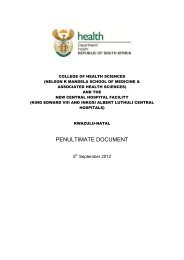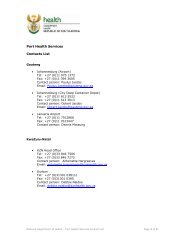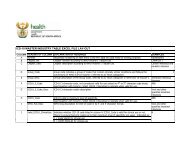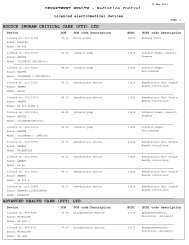National Norms and Standards relating to Environmental Health
National Norms and Standards relating to Environmental Health
National Norms and Standards relating to Environmental Health
Create successful ePaper yourself
Turn your PDF publications into a flip-book with our unique Google optimized e-Paper software.
Alternative emergency collection, treatment <strong>and</strong> disposal of health care risk waste shall beagreed upon between the health care risk waste facility <strong>and</strong> the waste managementcontrac<strong>to</strong>r; The location of temporary <strong>and</strong> central health care risk waste s<strong>to</strong>rage areas; <strong>and</strong> The collection points, routes <strong>and</strong> times of the HCRW from the temporary HCRW s<strong>to</strong>rageareas.2.10 CLASSIFICATION OF HEALTH CARE RISK WASTEEHPs should moni<strong>to</strong>r HCRW <strong>to</strong> ensure that they are classified as follows:a) All health care waste must be classified in accordance with SANS 10228, <strong>and</strong> furtherclassified/divided in accordance with the hazard <strong>and</strong> risk involved. According <strong>to</strong> technical guidelineson environmentally sound management of biomedical <strong>and</strong> health care waste provided by theconference of parties <strong>to</strong> the Basel convention on the control of transboundary movements ofhazardous waste <strong>and</strong> their disposal, health care waste is classified as follows:• Category A: <strong>Health</strong> care general waste e.g. office waste, food or garden waste• Category B: Biomedical <strong>and</strong> health care waste requiring special attention includes Human ana<strong>to</strong>mical wastes such as human body parts, organs <strong>and</strong> tissues; Pharmaceutical waste such as , cy<strong>to</strong><strong>to</strong>xic pharmaceutical waste, expired pharmaceuticals, <strong>and</strong>wastes containing heavy metal <strong>and</strong> non hazardous pharmaceutical waste such cough syrups; Waste sharps such as needles, scalpel blades• Category C: Infectious <strong>and</strong> highly infectious waste.Infectious waste include , discarded materials (disposable gloves, line, aprons) <strong>and</strong> equipmentscontaminated with blood <strong>and</strong> other body fluids from patients with hazardous communicable diseases<strong>and</strong> from patients with blood borne infections undergoing haemodialysis. Highly infectious wasteinclude microbiological waste with any kind multiple pathogens <strong>and</strong> labora<strong>to</strong>ry waste such as cultureswith viable biological agents• Category D: Other hazardous waste includes chemical waste such as empty aerosol cans, heavymetal waste <strong>and</strong> discarded chemical disinfectants• Category E: Radioactive waste includes liquids, gases, solids contaminated with radionuclide’swhose ionizing radiation have geno<strong>to</strong>xic effects2.11 SEGREGATION OF WASTE AT A HEALTH CARE FACILITYSegregation refers <strong>to</strong> the separation of waste in<strong>to</strong> different types of recyclable, reusable <strong>and</strong> disposablewastes. Segregation is one of the most important steps <strong>to</strong> successively manage HCRW.a) An EHP should conduct audits in a health facility <strong>to</strong> moni<strong>to</strong>r waste segregation practices <strong>and</strong> ensurethat acceptable methods are adopted.b) In accordance with the NEMA: Waste Act, waste genera<strong>to</strong>rs must reduce adopt methods <strong>and</strong>practices <strong>to</strong> reduce the generation of waste where possible, <strong>and</strong> segregate waste with the aim ofminimization (reuse, reduce, recycle <strong>and</strong> recover).c) <strong>Health</strong> care waste must be segregated correctly at the point of generation, <strong>and</strong> be containerized <strong>and</strong>correct liners used.d) All workers/employees shall be trained in the correct identification <strong>and</strong> segregation of the wastegenerated.e) An EHP should moni<strong>to</strong>r the collection of waste in a health facility <strong>to</strong> ensure that the facility containersused for the s<strong>to</strong>rage of waste complies with the following requirements waste:• Waste containers are SABS approved;• General waste is s<strong>to</strong>red in plastic bags with thickness of 80µm or more, or approved refusereceptacles or bulk steel containers for the s<strong>to</strong>rage of any generated building waste or garden waste• <strong>Health</strong> care risk waste containers are labeled with colour codes <strong>and</strong> the international biohazardsymbol for health care risk waste as per (SANS 10248-1:2008 Annexure F- extract) as follows:Table 1:Waste Waste sub-category Colour coding LabellingHuman or animal Infectious human RED • Marked “infectious waste”DOH. <strong>Norms</strong> <strong>and</strong> st<strong>and</strong>ards for environmental health in South Africa Feb 2013 126


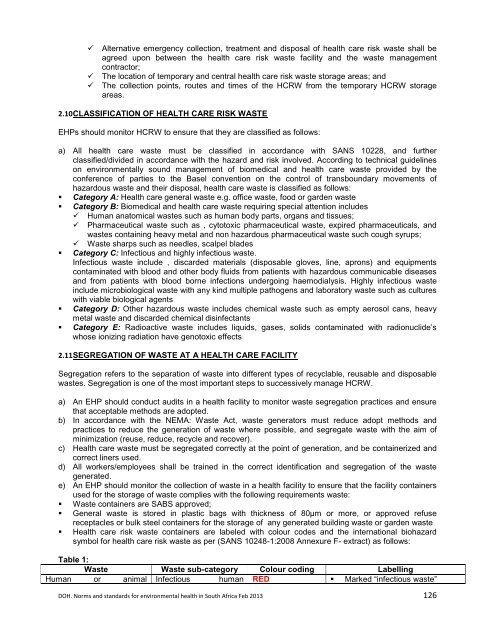
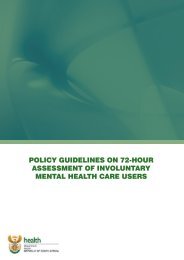

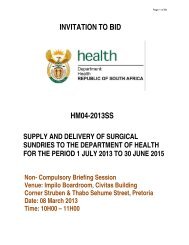
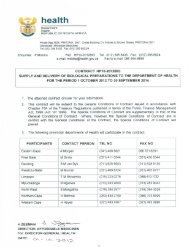
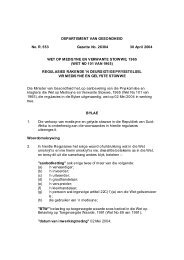
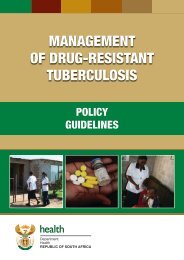
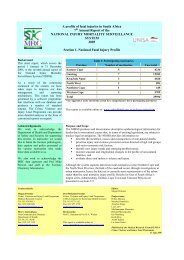
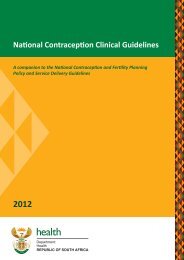
![A monograph of the management of postpartum haemorrhage [2011]](https://img.yumpu.com/15578784/1/184x260/a-monograph-of-the-management-of-postpartum-haemorrhage-2011.jpg?quality=85)
